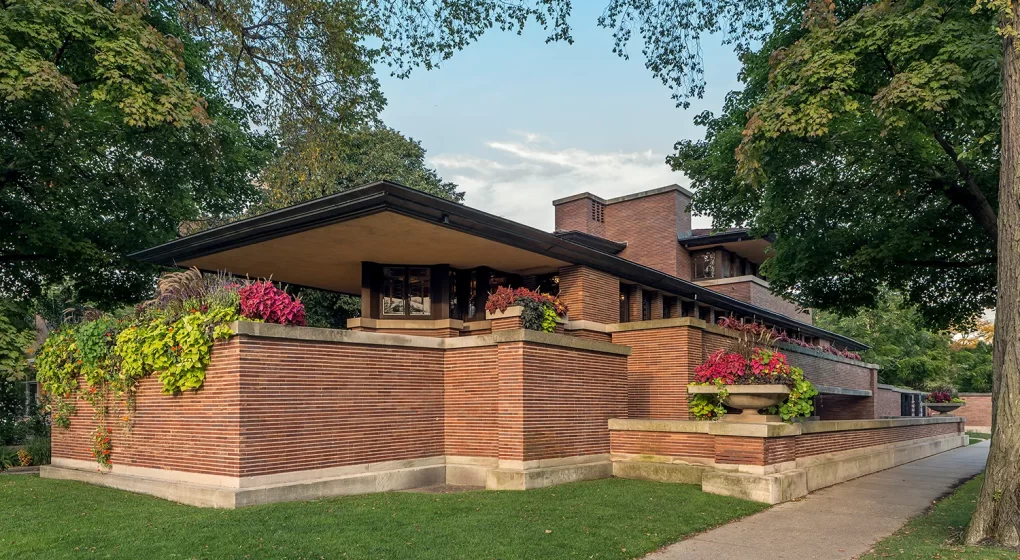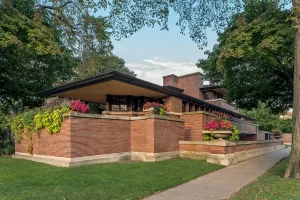

The Frederick C. Robie House, a U. S. National Historic Landmark, on the University of Chicago campus at South Woodlawn Avenue.
“For the wonder of each hour, / Of the day and of the night, / Hill and vale and tree and flower, / Sun and moon and stars of light / Christ, our Lord, to you we raise/ This our grateful hymn of praise.”- Folliott S. Pierpont, 1864 – For the Beauty of the Earth
“He has made everything beautiful in its time. He has also set eternity in the human heart.”- Ecclesiastes 3:11 (NIV)
Frank Lloyd Wright designed the Robie House as two large rectangles that seem to slide right past each other. Thus, the long, horizontal residence created for 28-year-old Frederick Robie boldly established a new form of domestic design. The Prairie style. In addition, Wright discarded the typical maze of small rooms for a light-filled open plan, centered around a main hearth. Above all, the meticulously coordinated design serves as a measuring stick for all other Prairie School buildings.
However, after fourteen months, financial problems incurred by his father’s death and the deterioration of his marriage forced Robie to sell. Then, in 1957, Chicago Theological Seminary announced plans to demolish the house. And replace it with a dormitory! An international outcry arose. Wright himself, then almost 90 years old, came to lead the protest to preserve the landmark. Finally, the Frank Lloyd Wright Trust completed restoration of the Robie House to its 1910 appearance in 2019.
Writing in The Beauty Chasers (2022), Timothy Willard underscores the need to broaden our view of beauty. Not so we can let beauty mean whatever we want it to mean. Rather, so we can take in the wonder of God – for the wonder of each hour. Consequently, Timothy sees beauty as a staging point for something grander. Furthermore, as beauty shines from within and from the surface, it mixes the temporal with the infinite. Beauty flies in the face of disappointment and failure. And it achieves this arm in arm with hope.
Most significantly, seeing involves more than looking. In seeing you contemplate the object, reflect on the event, consider the person. And it’s an act of knowing. As Creator of the world, God’s qualities rest like fingerprints all over the Father’s world. So, everything we interact with in this world points to God’s first strokes of wonder. Hence, Timothy exhorts, we need to create spaces that reflect the nature of God: symmetry of place, space for light, an invitation to the created order.
We, then, bear responsibility for reflecting God the Father’s excellent virtues in all we do and the spaces we use to engage. And, Timothy stresses, this holds true for buildings we construct as well as nature and the land. It matters how we build homes and churches. Because the grammar of shape reflects life. God wired us to bring symmetry and beauty into our homes. Also, the golden ratio in architecture reflects the natural world and the objects within it possessing that ratio. For the charm and glory of such beauty point to someone ‘wholly other’ – God.
Finally, Timothy states, in the harmony of space we call home we sense something other. Familiar, yet beyond our reach. Yet, it’s also something close. Something we desire to create in our gathering spaces and homes – heaven. For the wonder of each hour, we need to move beyond reason to awe. Because, Mark Batterson writes:
“Reason will take you only as far as your mind can go, but no further. And that isn’t far enough. Not if you truly love God. Only holy curiosity will get you where God wants you to go. And it’s a place way beyond reasonableness.”

